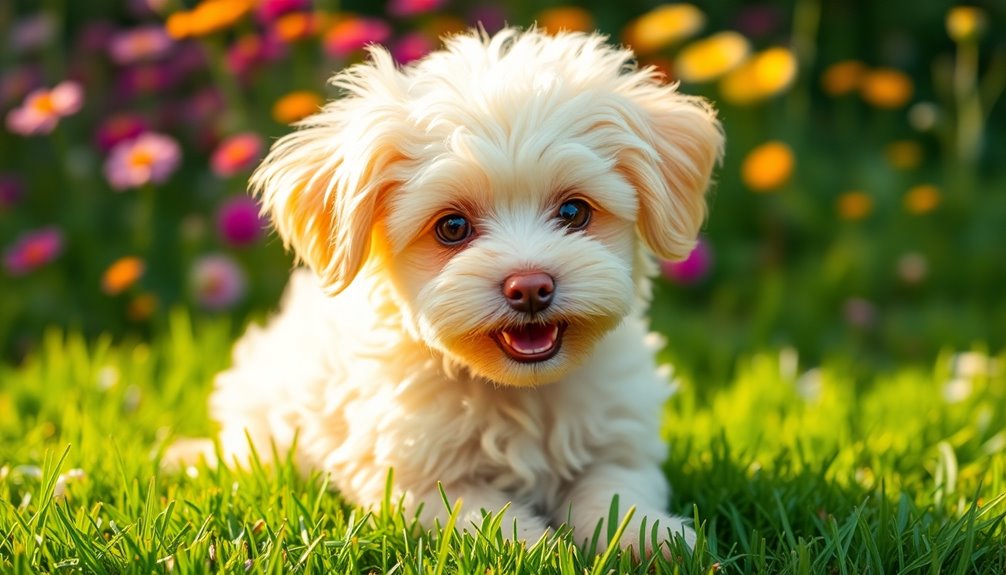The Teddy Bear is an adorable designer breed that melts hearts with its fluffy, soft coat and friendly personality. These small dogs, combining traits from breeds like Shih Tzu and Poodle, stand about 9 to 12 inches tall and weigh between 6 to 14 pounds. They're affectionate, playful, and thrive on socialization, making them perfect for families and individuals alike. Their hypoallergenic coats are low-shedding, ideal for allergy sufferers. Regular grooming and daily exercise keep them happy and healthy. If you're curious about more features and care tips for this sweet breed, there's plenty more to explore!
Key Takeaways
- Teddy Bears are small, fluffy dogs known for their affectionate and playful personalities, making them ideal companions for families and individuals.
- They originated in the 1990s from crosses of small breeds like Shih Tzu and Maltese, aimed at creating hypoallergenic pets.
- Regular grooming is essential to maintain their soft coats and minimize allergens, making them suitable for allergy sufferers.
- Daily exercise, including walks and indoor play, is necessary to keep them physically and mentally stimulated.
- With a lifespan of 12 to 16 years, proper care and regular veterinary visits can enhance their overall health and longevity.
Introduction
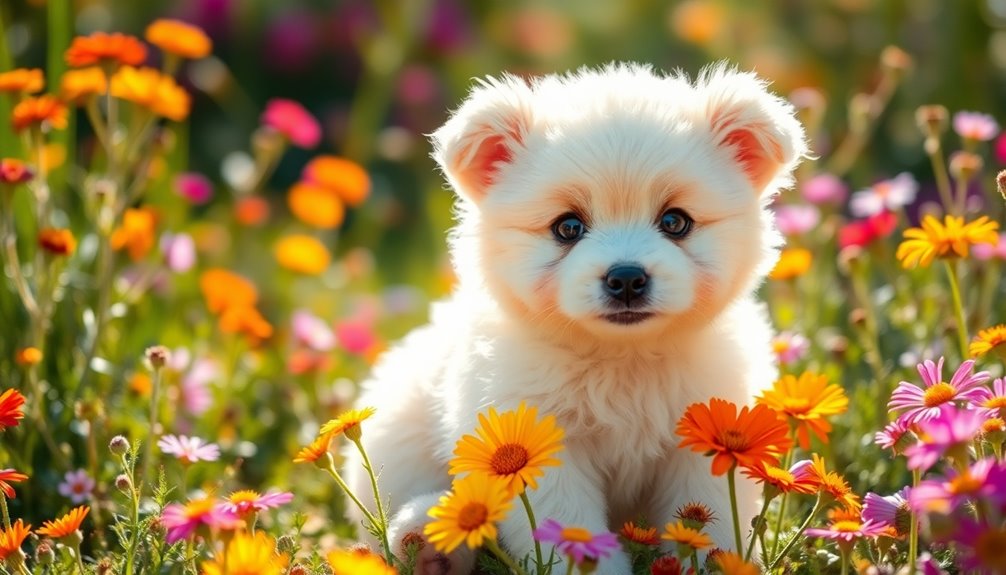
Introducing the charming Teddy Bear Designer Breed, you'll quickly discover why these dogs are beloved by many. They stand at a petite height of no more than 12 inches and weigh between 8 to 12 pounds, making them perfect companions for any living situation.
With their soft, fluffy coats that resemble a teddy bear, these dogs are as adorable as they're cuddly. Plus, they're hypoallergenic, shedding very little fur, which is a bonus for allergy sufferers.
Their temperament is a delightful mix of affection and liveliness. Teddy Bears thrive on human interaction, enjoying cuddles and playtime with family members. They're social creatures, getting along well with both strangers and other dogs. However, it's essential to socialize them properly to prevent separation anxiety. Their unwavering support for their families makes them incredibly loyal companions.
When it comes to grooming, regular care is needed to maintain their fluffy appearance, but they don't require extensive exercise. A few daily walks or play sessions are enough to keep them fit.
Their intelligence makes training a breeze, especially when you use positive reinforcement. With a little engagement and varied activities, you'll keep your Teddy Bear happy and well-behaved!
History and Origin

The teddy bear breed has its roots in the early 20th century, sparked by a memorable hunting trip involving President Theodore Roosevelt. As these bears gained popularity, they quickly became cherished companions, offering emotional support to many. Teddy bears originated as a symbol of childhood innocence and comfort, reflecting a deep connection between plush toys and the comfort they provide.
Where and when the breed originated
In the 1990s and early 2000s, the Teddy Bear designer breed emerged in the United States as a charming blend of small companion dogs. This delightful breed resulted from crossing various small breeds like the Shih Tzu, Bichon Frise, Maltese, and sometimes Poodle. The goal was to create a small, hypoallergenic, and incredibly cute dog that could appeal to dog lovers everywhere. Teddy Bear dogs gained popularity for their adorable looks, friendly personality, and low maintenance requirements, making them a favored choice for those seeking a small companion.
While no specific city or region is pinpointed as the exact birthplace of the Teddy Bear, its popularity skyrocketed shortly after the first litters were born. These dogs became part of the designer dog trend, capturing the hearts of families and fashion enthusiasts alike.
Though they're known by various names like Zuchon, Shichon, Mal-Shi, and Malti-Zu, they all share the same endearing characteristics.
Importantly, the Teddy Bear isn't recognized as a purebred breed by major kennel clubs, such as the AKC, which means it doesn't have the same formal status as other breeds. However, that hasn't stopped it from winning over countless fans with its fluffy appearance and sweet demeanor.
Companionship and Emotional Support
Teddy Bears aren't just adorable companions; they also play significant roles in providing emotional support and comfort. You'll find that these cuddly friends offer reassurance during tough times, acting like a warm embrace when you need it most. They become lifelong companions, fostering a sense of security and nostalgia that remains with you through the years.
In clinical settings, teddy bears often help alleviate anxiety and promote emotional well-being. They provide familiarity and comfort in healthcare environments, making medical treatments a little less daunting. Their presence eases distress, allowing you to feel more at ease. This is particularly important as teddy bears have been recognized for their positive impacts on emotional well-being through psychological studies. In fact, similar to pet therapy, they can enhance emotional well-being and reduce feelings of isolation.
These plush friends hold sentimental value, symbolizing cherished childhood memories and the comfort of companionship. You may have formed an attachment during pivotal moments, like times of illness or personal challenges. Received as meaningful gifts, they often become trusted confidants, supporting you through the ups and downs of life.
Teddy Bears also play a vital role in therapy, helping children cope with insecurity, fear, and trauma. They foster social interactions and reduce anxiety, making them invaluable tools for emotional healing.
In essence, these adorable creatures symbolize love, empathy, and the innocence of childhood.
Physical Characteristics
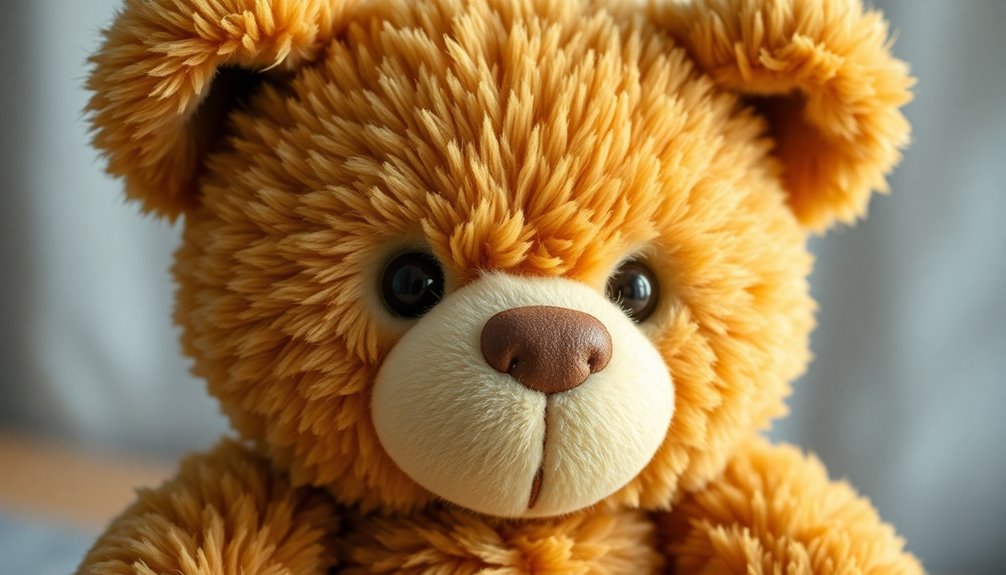
When you think of teddy bears, picture their small size and lightweight feel, making them perfect for cuddling.
Their fluffy, curly fur adds to that inviting texture, making you want to snuggle up with one immediately.
Each bear's unique coat can really enhance its charm and appeal, giving it a personality all its own. Teddy bears evoke feelings of comfort and security and can provide a sense of emotional safety that enhances the experience of cuddling.
Size, weight, and coat details
The charming appearance of the Teddy Bear designer breed captivates many with its compact size and soft, fluffy coat. Typically, these adorable pups mature to a height of 9 to 12 inches and weigh between 6 to 14 pounds, although some variations may reach up to 20 pounds depending on their breed mix. You'll usually find that they reach full size between 12 to 18 months, making it easy to plan for their growth.
When it comes to coat colors, Teddy Bears come in a delightful array of options, including white, brown, black, grey, and yellow. You'll frequently see combinations like brown and white or black and white patterns, showcasing the unique blend of their parent breeds. Additionally, their soft, hypoallergenic coat makes them a preferred choice for families with allergy sufferers.
It's important to monitor their weight closely, as genetics and diet significantly influence it. Maintaining a proper diet is crucial, as overweight Teddy Bears can face serious health issues.
Their coats aren't only soft and fluffy but also hypoallergenic, which is a bonus for allergy sufferers. Regular grooming is essential to keep their coats looking their best and prevent matting.
Fluffy, Curly Fur Texture
Fluffy, curly fur is one of the standout features of the Teddy Bear designer breed, giving them an enchanting, plush-like appearance that many find irresistible. You'll notice their fur can be curly, wavy, or even straight, but it's generally soft and fluffy, reminiscent of a beloved stuffed animal.
Most Teddy Bears have a double coat, consisting of a softer undercoat and a longer outer coat, making them a joy to pet. In fact, many of these bears are made from soft fabric options that enhance their cuddly feel and appearance. Regular grooming helps maintain their coat, as it is important for promoting active listening during grooming sessions, which can also strengthen the bond between pets and their owners.
Grooming is essential to keep that beautiful coat in shape. You'll want to brush them daily with a slicker brush to prevent tangling and matting. Regular trimming is necessary, especially around the eyes, ears, and paws, to maintain their charming look.
One of the best things about Teddy Bears is their hypoallergenic qualities. Many are low-shedding, making them suitable for allergy sufferers, and their coats often produce fewer allergens, allowing them to thrive in various environments.
With their fluffy fur, expressive eyes, and adorable button noses, these pups truly look like live teddy bears, captivating everyone they meet!
Temperament and Personality
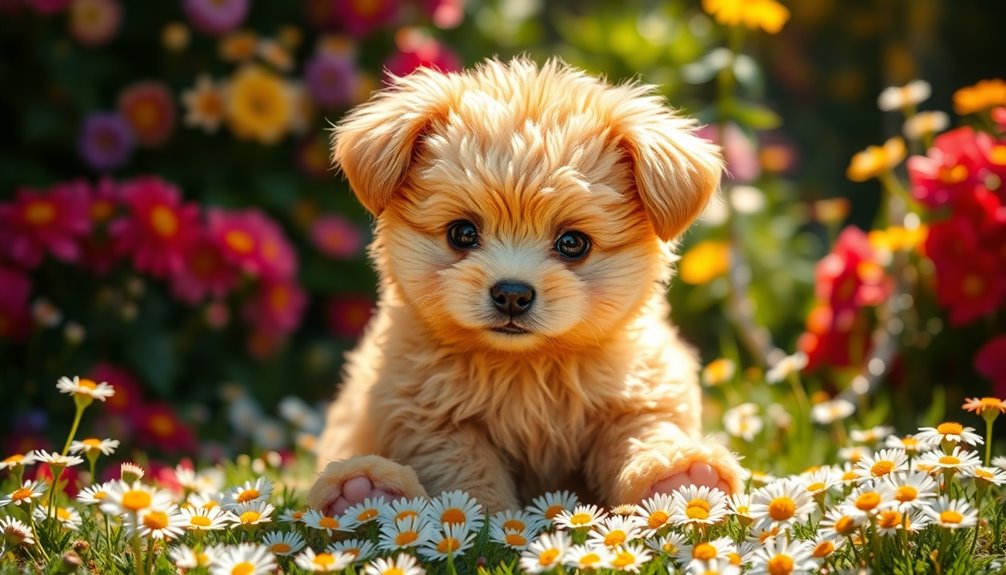
When you welcome a Teddy Bear into your home, you're getting a playful and friendly companion. Their gentle nature makes them a perfect fit for families, individuals, and even other pets. With their eagerness to bond and socialize, these dogs bring joy to any environment. Teddy Bear dogs are known for their low-shedding coats, making them appealing to allergy sufferers.
Playful and Friendly Demeanor
Although Teddy Bear Designer Breeds may be small in size, their playful and friendly demeanor makes a big impression. These little bundles of joy love engaging in games like hide-and-seek, solving treat puzzles, and chasing their favorite chew toys.
You'll find they've boundless energy, enjoying activities like fetching and swimming, all while being perfectly suited for apartment living. Their low energy output makes them ideal companions for those who enjoy a more relaxed lifestyle. Regular outings for puppy socialization can further enhance their adaptability and confidence.
Their sociable nature shines through as they form strong bonds with you and your family. These dogs are gentle and affectionate, thriving on love, cuddles, and pampering.
While they're generally quiet, they may experience separation anxiety if left alone for too long, so they appreciate your company.
Teddy Bears respond well to positive reinforcement, making training sessions a breeze. They're eager to please, which enhances their adaptability in various environments, allowing them to get along with other pets and children alike.
With their warm personalities and playful spirit, Teddy Bear Designer Breeds bring joy to any household, proving that their small stature doesn't diminish the big love they offer.
Suitability for families, individuals, or other pets
Teddy Bear Designer Breeds are a perfect match for families, individuals, and other pets alike, thanks to their loving and adaptable personalities.
These dogs are incredibly family-friendly, thriving in homes with children of all ages. Their gentle demeanor allows them to bond deeply with each family member, making them excellent companions for both seniors and families with small children.
If you're an individual, you'll find Teddy Bears are ideal pets. They adapt easily to various living environments, whether you have a spacious house or a cozy apartment. Just remember, they appreciate regular interaction and may develop separation anxiety if left alone for too long. Their hypoallergenic characteristics also make them great for those who suffer from allergies, ensuring that everyone can enjoy their company.
Teddy Bears also get along well with other pets, thanks to their patient and gentle nature. They can live harmoniously with dogs of different sizes, as well as other household pets, provided they receive proper socialization.
Their eagerness to please makes them easy to train, which is great for first-time dog owners. With consistent positive reinforcement, you can help mitigate any behavioral issues, ensuring a happy and well-adjusted companion.
Health and Lifespan
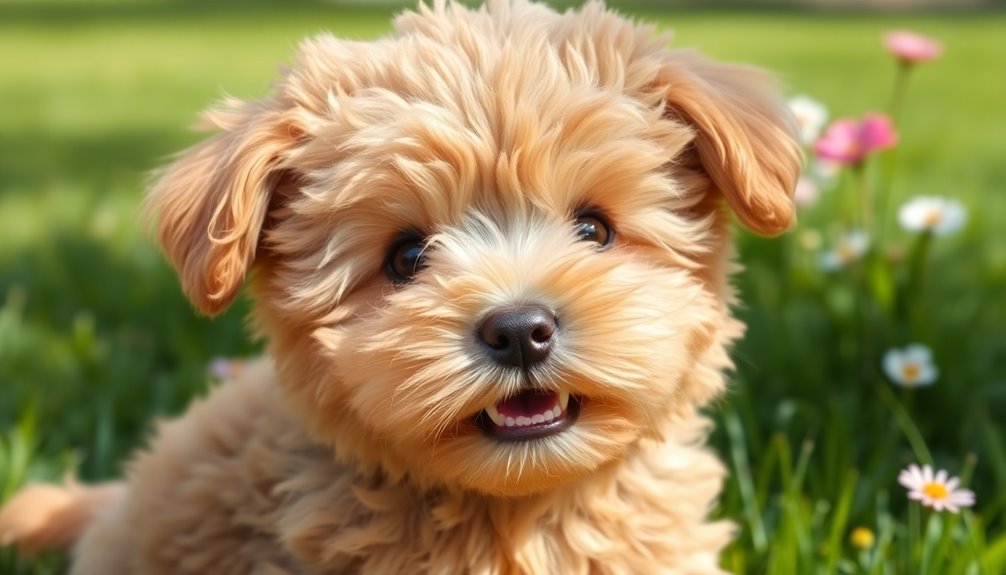
When it comes to the health and lifespan of your Teddy Bear, you should be aware of common concerns like dental issues and allergies. These factors can influence their typical lifespan of 12 to 16 years, but with proper care, they can live even longer. Regular veterinary visits can help monitor general health and detect any potential issues early on.
Typical lifespan of the breed
For those considering a Teddy Bear designer breed, understanding their typical lifespan is crucial. These adorable dogs generally live between 12 to 16 years, making them quite a long-lived option compared to other small breeds. Some Teddy Bears can even reach up to 15 years or more, depending on various factors.
Genetics play a significant role in determining lifespan, but you can influence it too. A balanced diet is essential for keeping your Teddy Bear healthy, along with regular veterinary check-ups to catch any potential issues early. Regular veterinary care, diet, nutrition, and environmental factors significantly influence cat longevity as well, and similar principles can be applied to the care of Teddy Bears.
Daily exercise, like walks and playtime, isn't just fun; it's vital for their physical and mental well-being. You'll also want to prioritize dental hygiene to prevent dental problems, as many small breeds are prone to these issues.
Creating a stimulating home environment is important, as Teddy Bears thrive on companionship and don't do well alone for extended periods.
Common health concerns or genetic predispositions
Health is a vital consideration for anyone thinking about bringing a Teddy Bear designer breed into their home.
Like many designer breeds, Teddy Bears can inherit health issues from their parent breeds. One significant concern is Polycystic Kidney Disease (PKD), which can affect their kidney function. This genetic condition is inherited from parent breeds like the Selkirk Rex, which has a moderate risk due to shared ancestry with breeds known for PKD.
Another worry is Progressive Retinal Atrophy (PRA), which can lead to vision loss and eventual blindness. While the risk is low in Teddy Bears, it's still crucial to ensure that the breeding parents undergo genetic testing to identify potential carriers. Additionally, the overall health and longevity of these cats can be supported through regular veterinary check-ups.
Furthermore, Hypertrophic Cardiomyopathy (HCM) poses a risk, especially in cats with heart murmurs.
Regular veterinary check-ups are essential for early detection, as no genetic test is available for this condition.
Tips for maintaining health and wellness
Maintaining the health and wellness of your Teddy Bear designer breed is essential for ensuring a long, happy life. Start with a balanced diet. Feed high-quality puppy food until your pup is at least one year old, then transition to regular adult kibble if desired. Keep an eye on their weight to prevent obesity, which can lead to serious health issues.
Dental hygiene is crucial. Brush your dog's teeth regularly using dog-specific toothpaste, and provide chew toys to help reduce plaque buildup. Schedule regular dental check-ups to prevent gum disease.
Exercise them daily with at least 30 minutes of walks. Engage in indoor play, like fetch or hide-and-seek, to keep their minds stimulated. Remember, their exercise needs may vary based on age and temperament. Low energy levels make them suitable for homes without large yards, so be mindful of their activity preferences.
Grooming is also important. Brush their coat 2-3 times a week to prevent matting and bathe them only as needed to avoid skin irritation.
Don't forget to trim their nails, clean their ears, and schedule regular veterinary visits. With the right care, your Teddy Bear can thrive and bring joy for years to come.
Care Requirements

Taking care of your teddy bear involves regular brushing to keep its fur looking fresh and clean. You should also consider its exercise needs, as playful interactions can help maintain its energy levels. Additionally, practicing proper care can extend the lifespan of your bear, ensuring it remains a cherished companion for years to come. Lastly, feeding tips and diet recommendations can ensure your bear stays in tip-top shape for all those cuddles.
Regular Brushing Required
Regular brushing is essential for keeping your Teddy Bear designer breed looking its best and feeling comfortable. Aim to brush your dog daily or at least a few times a week to prevent matting and tangling. This routine helps remove loose hair, dirt, and debris while stimulating new hair growth and distributing natural oils, promoting a healthy coat and skin.
Focus on high-friction areas, like under the collar and behind the ears, where tangles often develop. A slicker brush is effective for tackling mats, and a comb with wide-set teeth can help with grooming. Consider using detangler sprays to ease knots and prevent mats from forming. Regular brushing not only makes grooming smoother but also helps your puppy get accustomed to the process. Frequent brushing contributes to your dog's overall health by allowing for early detection of skin issues or other health concerns. It also prevents discomfort caused by matting while promoting clean ears, reducing the risk of infections. Additionally, the teddy bear dog breeds are known for their soft, fluffy coats, which require diligent grooming to maintain their appearance.
To maintain your Teddy Bear's coat, schedule professional grooming every 6 to 8 weeks, ensuring they receive a bath, trim, and thorough brushing.
Exercise requirements and energy levels
A well-groomed Teddy Bear designer breed thrives on a balanced routine that includes physical activity. Daily walks are essential, so plan for 20 to 30 minutes each day. These walks not only provide physical exercise but also offer mental stimulation, keeping your furry friend engaged.
In addition to walks, allocate time for play, whether indoors or in a securely fenced yard. Short play sessions throughout the day help manage their moderate energy levels and prevent boredom. Teddy Bears are adaptable, fitting into various lifestyles, whether you're in an apartment or a house with a yard. They enjoy games like fetch and chase but also love curling up on your lap for a cozy rest. You can adjust their exercise routine based on their individual needs and your family's lifestyle.
Including them in family activities, like trips to the dog park, will keep them happy and social. It's important to note that Teddy Bears generally prefer human company, so spending quality time together is vital for their happiness.
Don't forget about mental stimulation! Incorporating puzzle toys and engaging training sessions will ensure your Teddy Bear remains sharp and satisfied.
With consistency in exercise and socialization, you'll have a well-rounded companion full of joy and energy.
Feeding tips and diet recommendations
Feeding your Teddy Bear designer breed requires careful attention to their unique nutritional needs. These small and toy breeds need a balanced diet rich in proteins, fats, carbohydrates, vitamins, and minerals. Because they've a high metabolism, they require more calories per pound than larger dogs. Opt for nutrient-dense food to prevent overeating while maintaining their energy levels.
Feed your Teddy Bear 3-4 times a day to stabilize blood sugar levels. For puppies, increase this to 4-6 meals daily to avoid hypoglycemia. Divide their total daily food into smaller portions, and always consult the feeding guidelines on your dog food packaging, adjusting for age, activity level, and health. Caloric requirements are higher per pound for toy breeds compared to larger breeds, so be mindful of portion sizes.
Select high-quality dog food specifically formulated for small breeds, featuring real meat, whole grains, and vegetables. Avoid artificial additives. Brands like Blue Buffalo, Royal Canin, and Hill's Science Diet are great options.
Treats should be given sparingly, and consider supplements like Nutri-Cal® to prevent hypoglycemia in puppies. If your puppy isn't eating, hand feed or use syringes to ensure they get enough nutrition.
Remember to gradually transition between foods to avoid digestive upset.
Training and Socialization

When training your Teddy Bear, you'll notice they're moderately responsive to commands, so patience is key. Consistent reinforcement of leadership ensures that they understand who is in charge, which is essential for their obedience. Gradually introducing them to new friends can help prevent separation anxiety and build their confidence.
Moderately Responsive to Commands
During the early stages of training, Teddy Bear puppies are moderately responsive to commands, making it essential to establish a solid foundation. Start with basic commands like "sit," "stay," and "come." Use positive reinforcement methods, rewarding your puppy with treats and praise when they follow your commands. Consistent hand signals alongside verbal cues can avoid confusion and promote faster learning.
Keep training sessions short and engaging, ideally lasting 5 to 10 minutes. This approach helps maintain your puppy's focus and enthusiasm. Clicker training can also be effective; it marks desirable actions and enhances their response speed. Additionally, their friendly nature makes Teddy Bear puppies eager to please, which can facilitate the training process.
It's vital to have a consistent training schedule, as this reinforces good behavior and builds trust. If your puppy struggles, be patient and break commands into smaller, manageable steps. Adapt your training environment, using various settings like your living room or yard to keep things interesting.
Lastly, remember that socialization goes hand-in-hand with training. Early exposure to different people and environments is crucial for building confidence and preventing fearfulness, setting the stage for a well-rounded, obedient companion.
Gradual Introductions to New Friends
Gradually introducing your Teddy Bear puppy to new friends is crucial for their social development. These puppies are naturally outgoing and friendly, but overwhelming them with too many new experiences at once can lead to anxiety. It's important to recognize that creating a positive environment aligns with the principles of emotional alignment, which can foster a sense of safety.
Start by exposing your puppy to one new person or dog at a time, allowing them to feel comfortable and safe. Use positive reinforcement techniques like praise and treats to encourage good behavior during these introductions.
When meeting other dogs, ensure the interactions are slow and controlled. Teddy Bear puppies thrive on companionship, so consistent playdates can help them develop a friendly disposition. It's important to note that they can develop separation anxiety if left alone for extended periods, making socialization even more critical.
Likewise, if you have non-canine pets, introduce them gradually, reinforcing positive associations through treats and supervision. Keeping a focus on their emotional well-being is essential, as it can significantly influence their ability to connect with others.
It's essential to create a positive environment during these introductions. Patience and consistency are key—make sure everyone in the family uses the same training methods.
Early socialization helps your Teddy Bear puppy adapt to various environments and build strong bonds with both human and animal companions. By taking it step-by-step, you'll set your puppy up for a happy, well-adjusted life.
Separation Anxiety Tendencies
Addressing separation anxiety in Teddy Bear puppies requires understanding their unique emotional needs and behaviors. These breeds, known for their high-energy and affectionate personalities, are particularly susceptible to separation anxiety, affecting about 14% of canines. Symptoms like excessive salivation, self-mutilation, and overt chewing often emerge when they're left alone. Additionally, Teddy Bear dogs tend to form strong attachments to their owners, which can exacerbate their anxiety when separated.
To combat these issues, positive reinforcement training is essential. Rewarding calm behavior rather than punishing anxious responses helps foster a sense of security. Establish a consistent training schedule with short, frequent sessions, and use the same commands to avoid confusion.
Gradually teaching your puppy to spend time alone can also alleviate anxiety over time. Early socialization plays a critical role in building confidence and reducing anxious tendencies. Expose your Teddy Bear puppy to diverse environments, people, and other dogs.
As the pack leader, set clear boundaries and expectations, reinforcing positive interactions with treats and praise. Understanding what motivates your puppy ensures effective training and strengthens your bond. By addressing these separation anxiety tendencies early on, you'll help create a happier, more secure companion.
Ideal Living Environment
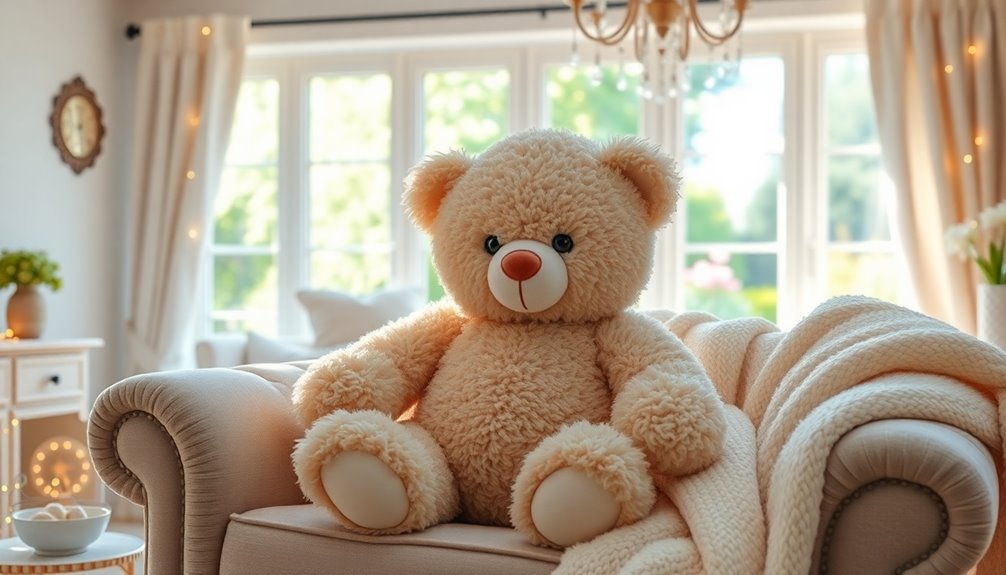
If you live in an urban apartment with a balcony, you'll find that a Teddy Bear can thrive in your space. Their small size and adaptable nature make them perfect companions, even in cozy settings, as long as they've some outdoor area for fresh air. Plus, they can handle various humidity levels, so they'll feel right at home in your environment. Additionally, their moderate energy level means they enjoy playtime but do not require excessive exercise, making them well-suited for apartment living.
Urban Apartment With Balcony
Urban apartments with balconies offer a unique blend of convenience and charm, making them an ideal living environment for city dwellers.
You'll enjoy easy access to public transportation, shopping districts, restaurants, and entertainment venues, which means you can reduce long commutes and make daily life more manageable. The walkability of your neighborhood allows for spontaneous outings, whether it's catching a show or grabbing dinner with friends.
Living in an urban setting immerses you in a vibrant cultural scene, providing opportunities to explore museums, theaters, and festivals. Additionally, urban dining experiences in cities provide a rich culinary landscape that enhances your lifestyle. The combination of urban living and major cruise lines offering unique itineraries can also inspire exciting travel opportunities.
Community events organized by your apartment complex help foster connections with neighbors, allowing you to build a sense of belonging.
Modern amenities enhance your living experience, from fitness centers and swimming pools to rooftop terraces.
With professional management and concierge services, you'll have peace of mind knowing maintenance is handled promptly.
Plus, the financial benefits are appealing; you'll typically face lower costs compared to house mortgages while enjoying the perks of contemporary designs and efficient living spaces.
Humidity Tolerance Levels
Maintaining the right humidity levels is crucial for the health and well-being of Teddy Bear designer breeds and other cats. The ideal humidity range for them lies between 30% and 50%. Staying within this range, as recommended by the Mayo Clinic, helps prevent health issues like dry skin, itchy fur, and respiratory problems.
If humidity dips too low, your cat might suffer from dehydration, dull fur, and even breathing difficulties, especially if they've asthma or allergies. Proper humidity also helps to reduce hairballs, which is beneficial for your cat's overall comfort.
On the other hand, high humidity can lead to bacterial and fungal growth, causing respiratory illnesses and skin infections. Excess moisture can also make the litter box unpleasant and exacerbate dehydration.
To maintain optimal humidity, consider using ultrasonic cool mist humidifiers for dry environments or dehumidifiers in more humid areas. Regularly opening windows for fresh air and ensuring your cat stays hydrated are also key.
Hypoallergenic Coat Benefits Owners
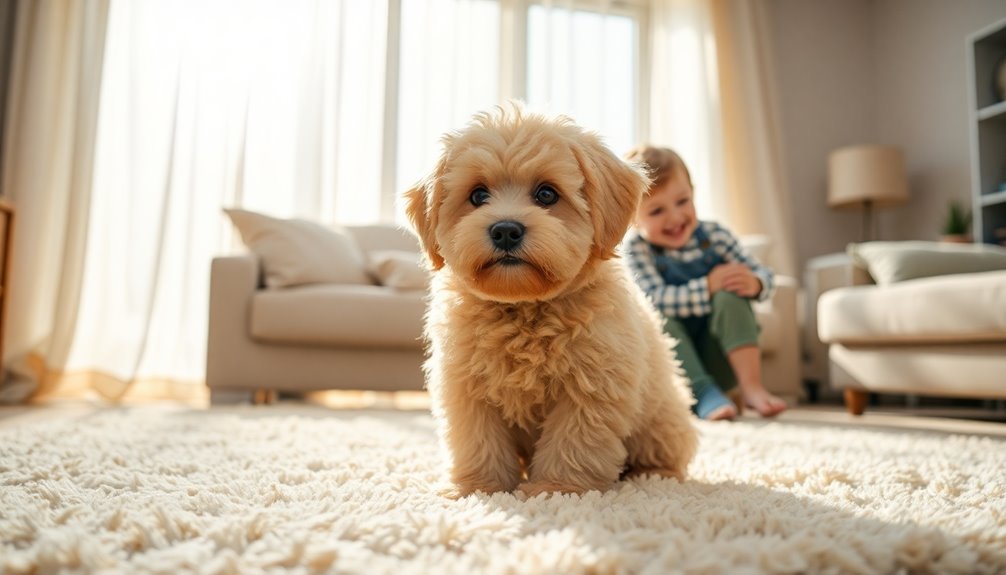
If you're considering a Teddy Bear dog, you'll appreciate their hypoallergenic coats that rarely shed, making them a great choice for allergy sufferers. These pups communicate in their own unique ways, often without excessive barking, which can be a plus in quieter environments. Plus, you'll likely see them featured in commercials, showcasing their charming traits that many families adore. Their plush coats not only enhance their adorable appearance but also contribute to their popularity as beloved companions.
Rarely Barks, Communicates Differently
Teddy bear dogs are known for their unique communication style, which often includes minimal barking and a reliance on body language. These adorable pups are generally quiet, making them a perfect choice for those who prefer a calmer environment.
While they may bark occasionally due to separation anxiety, especially when left alone for long periods, their friendly, sociable nature reduces the need for loud communication. Instead, they often use soft vocalizations like whining or gentle sounds to express their needs.
You'll notice your teddy bear dog might stand by their food bowl or the door, using body language to signal what they want. With positive reinforcement training, you can further enhance this communication, making it clearer for both of you. Dogs also interpret human emotions through scent, which can help them better understand their owners' feelings and needs in a remarkable way.
They're also known to use scent to convey emotions and status, similar to other dogs. Plus, with a bit of training, they can even learn to use buttons or bells to communicate.
This distinctive communication style not only keeps your home peaceful but also strengthens the bond between you and your teddy bear dog, making every interaction special.
Teddy Bear Dog in Commercials
The charming appeal of teddy bear dogs makes them a popular choice for commercials, showcasing their adorable features and friendly demeanor. These small dogs, typically weighing between 6-15 pounds, boast a soft, fluffy hypoallergenic coat that comes in a variety of colors. Their round eyes and button-like noses enhance their teddy bear-like appearance, making them irresistible to viewers. Additionally, their playful behavior encourages active engagement in families, promoting physical activity and social interaction.
One of the standout features of teddy bear dogs is their hypoallergenic coat, which produces minimal dander, making them ideal for allergy sufferers. This allergy-friendly trait allows families with sensitivities to enjoy a pet without the worry of allergic reactions. Additionally, their low-maintenance grooming needs mean you can spend more time enjoying their company rather than managing their coat. The joyful atmosphere created by these dogs often translates into heartwarming scenes that resonate with viewers.
Their affectionate and sociable nature shines through in commercials, as they get along well with both people and other pets. Teddy bear dogs are also easy to train, thanks to their intelligence and eagerness to please. This trainability ensures they behave well on set, adding to their commercial appeal.
Ideal for Apartment Living?
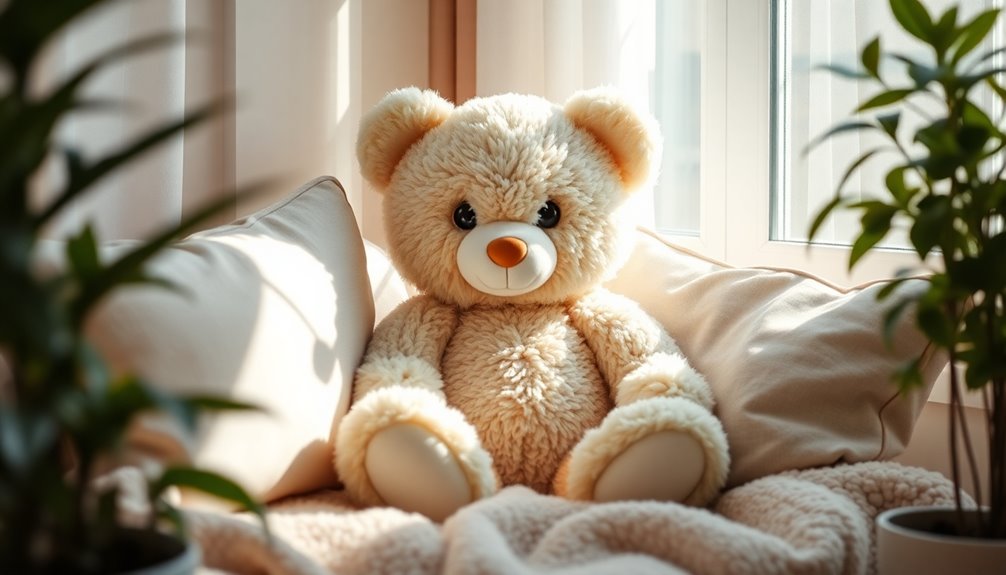
If you're considering a Teddy Bear designer breed for your apartment, you'll appreciate their calm demeanor and low activity levels. They adapt well to smaller spaces and can comfortably lounge around while you're busy. Plus, with their low grooming needs, they make an ideal choice for first-time owners who want a manageable pet. Their independent nature allows them to be alone for longer periods, making them suitable for busy renters.
Ideal for First-Time Owners
For first-time owners seeking a companion that's perfect for apartment living, a Teddy Bear designer breed stands out as an excellent choice.
These dogs are friendly, affectionate, and well-poised, making them easy to integrate into your life. Their calm demeanor allows them to adapt serenely to changes, ensuring a smooth transition for you both. Like the British Shorthair's unique traits, Teddy Bears thrive in social settings, enjoying the company of their human family and other pets. Additionally, their low to medium activity level means they can comfortably share their space with less active pets, like cats.
Teddy Bears thrive in small spaces, needing only a minimum of 20 square feet of personal space. They benefit from vertical areas for climbing, which provides them with a sense of security.
With a low to medium activity level, they don't require extensive exercise or large areas to roam. Instead, they enjoy playing and interacting within their environment, making them perfect for owners with little experience.
Additionally, Teddy Bears are compatible with other pets, including cats and sometimes even dogs. They bond well with siblings or pets of the same age and gender, which can enhance their socialization skills.
With their love for cuddling and playful nature, you'll find that a Teddy Bear brings joy and companionship to your apartment life.
Grooming Needs and Maintenance
Regular grooming is essential for maintaining a Teddy Bear's lovely coat, especially in an apartment setting.
The Teddy Bear Cut, crafted through hand scissoring and extension combs—never using scissors or naked clipper blades—ensures your cat looks adorable while minimizing shedding and matting. This grooming style requires a masterful groomer, as it involves trimming the body coat and styling the face, chest, feet, booties, and tail. Additionally, this grooming method reduces hair shedding significantly, which is beneficial for both your cat's health and your living space.
You'll need to schedule regular grooming appointments to keep the coat at its best length, but the cut's lower maintenance means fewer worries in between visits.
It's also a practical choice for colder weather, keeping your cat warm while managing hair length. However, if your cat has extensive matting, consider a Lion Cut instead.
Frequently Asked Questions
What Is the Average Cost of a Teddy Bear Puppy?
The average cost of a Teddy Bear puppy ranges from $500 to over $3,000.
You'll find that prices vary significantly based on the breeder and the puppy's genetics. If you're looking for a healthy pup, it's wise to invest in one from a reputable breeder who conducts health testing.
Generally, expect to pay between $1,495 and $3,500 for high-quality puppies with health guarantees.
Are Teddy Bears Good With Children and Other Pets?
Yes, they're great with children and other pets!
Their friendly and gentle nature makes them perfect for families, allowing kids to play safely. You'll find they enjoy interacting with children, keeping them entertained.
They also get along well with other pets, including cats, provided they're socialized early.
With consistent training and supervision, you can foster a harmonious relationship, making them wonderful companions for your whole family.
How Often Should I Groom My Teddy Bear?
You should groom your teddy bear every 4 to 6 weeks to keep their coat healthy and prevent matting.
Daily brushing is essential to manage their long, silky fur and reduce hairballs.
Regular grooming sessions also allow you to check for any health issues early.
Remember to use the right brushing technique and avoid sensitive areas like the tummy to keep your pet comfortable during the process.
Where Can I Find Reputable Breeders for Teddy Bears?
To find reputable breeders, start by researching local options and seeking recommendations from trusted sources.
Look for breeders who emphasize health and ethical practices, prioritizing the well-being of their dogs.
Check for affiliations with kennel clubs or associations that ensure quality.
Don't hesitate to ask about health guarantees and breeding transparency.
Reading customer reviews can also help you gauge their reputation and commitment to responsible breeding practices.
Your new furry friend deserves the best!
What Common Behavioral Issues Do Teddy Bears Exhibit?
Common behavioral issues you might notice in Teddy Bear dogs include aggression, such as nipping or barking at guests.
They often struggle with disobedience, like ignoring commands or chewing on inappropriate items.
Socialization problems can arise, leading to excessive barking at visitors.
To manage these behaviors, consistent training and clear boundaries are essential.
Implementing structured routines and communication tools can help you address these challenges effectively and enhance your dog's behavior.
Conclusion
In conclusion, the teddy bear dog truly is a delightful companion that brings joy and warmth to any home. With their charming looks and loving personalities, they're perfect for families, singles, and seniors alike. Their manageable size and hypoallergenic coats make them ideal for apartment living, while their playful nature keeps you entertained. If you're looking for a furry friend that melts hearts, a teddy bear dog might just be the perfect addition to your life!



